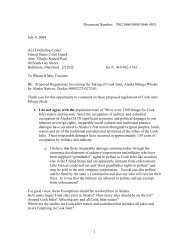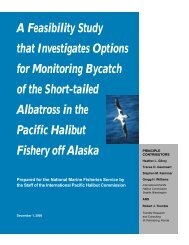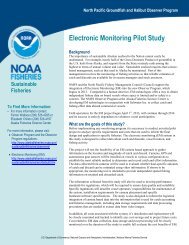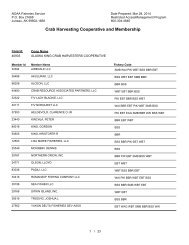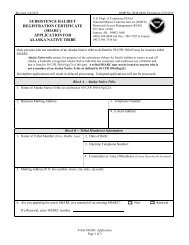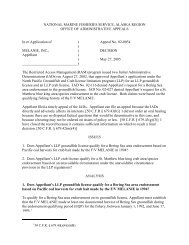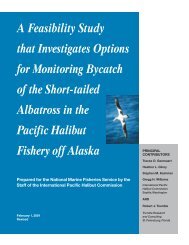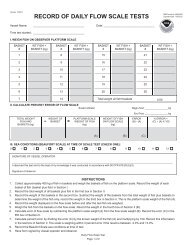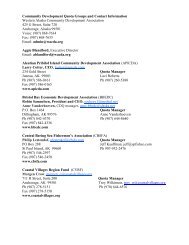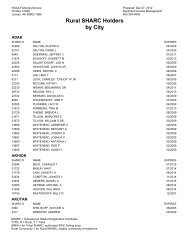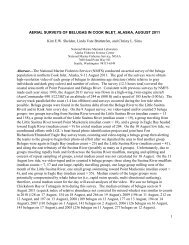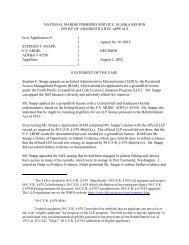Petition to List Lynn Canal Pacific Herring under the Endangered ...
Petition to List Lynn Canal Pacific Herring under the Endangered ...
Petition to List Lynn Canal Pacific Herring under the Endangered ...
Create successful ePaper yourself
Turn your PDF publications into a flip-book with our unique Google optimized e-Paper software.
Leon (1993) detected statistically significant differences in length-at-age and/or<br />
growth rates between three s<strong>to</strong>cks of <strong>Pacific</strong> herring in Sou<strong>the</strong>ast Alaska,<br />
separated from one ano<strong>the</strong>r by a minimum of 160 miles: 1) Sitka Sound, 2)<br />
Seymour <strong>Canal</strong>, and 3) Kah Shakes-Boca de Quadra. Comparison between two<br />
spawning sites separated by only 15-20 miles, Annette Island and Boca de<br />
Quadra, also indicated area-specific differences in growth characteristics (Leon<br />
1993).<br />
(S<strong>to</strong>ut et al. 2001).<br />
3. Morphologically Distinct<br />
<strong>Lynn</strong> <strong>Canal</strong> <strong>Herring</strong> are morphologically distinct from o<strong>the</strong>r <strong>Pacific</strong> <strong>Herring</strong>.<br />
Rounsefell and Dahlgren (1935) delineated six populations in Sou<strong>the</strong>ast Alaska, and <strong>the</strong><br />
<strong>Lynn</strong> <strong>Canal</strong> <strong>Herring</strong> were <strong>the</strong>n described as <strong>the</strong> “Juneau - Icy Strait area” as recounted by<br />
S<strong>to</strong>ut et al. (2001).<br />
Rounsefell and Dahlgren (1935) examined herring s<strong>to</strong>ck structure in Sou<strong>the</strong>ast<br />
Alaska, mainly through comparison of <strong>the</strong> mean number of vertebrae in different<br />
year-classes between 32 localities. Individual year-classes were studied, since a<br />
high negative correlation was found between temperature during development and<br />
<strong>the</strong> mean vertebral number in different year-classes. Rounsefell and Dahlgren<br />
(1935) identified six populations in Sou<strong>the</strong>ast Alaska that <strong>the</strong>y considered<br />
independent of one ano<strong>the</strong>r, based on a combination of differences in vertebral<br />
counts, growth rates, and year-class strength: 1) Juneau-Icy Strait area, 2) Sitka-<br />
Cape Ommaney-Chatham Strait area, 3) Noyes Island-west coast of Prince of<br />
Wales Island, 4) inner areas of Sou<strong>the</strong>ast Alaska, 5) vicinity of Petersburg, and 6)<br />
Todd-Peril Strait.<br />
(S<strong>to</strong>ut et al. 2001).<br />
More recently, <strong>the</strong> <strong>Herring</strong> S<strong>to</strong>ck ID Project (http://www.herrings<strong>to</strong>ckid.info/), a<br />
joint effort by ADFG and NMFS <strong>to</strong> delineate <strong>Pacific</strong> <strong>Herring</strong> populations using new<br />
techniques focused on <strong>the</strong> fatty acid levels in heart muscle, provides information that<br />
<strong>Lynn</strong> <strong>Canal</strong> <strong>Herring</strong> are morphologically distinct from o<strong>the</strong>r herring. The principal<br />
investiga<strong>to</strong>rs of <strong>the</strong> <strong>Herring</strong> S<strong>to</strong>ck ID Project recently published a paper detailing<br />
preliminary findings, Otis and Heintz (2003). They determined that herring populations<br />
in Sou<strong>the</strong>ast Alaska differ substantially from each o<strong>the</strong>r and from those found in <strong>the</strong><br />
nor<strong>the</strong>rn Gulf of Alaska and <strong>the</strong> Bering Sea.<br />
Ano<strong>the</strong>r important aspect of this work is that <strong>the</strong> authors reveal <strong>the</strong> limitations on<br />
relying on genetic evidence when it comes <strong>to</strong> herring. Otis and Heintz (2003) state that<br />
simply using genetic information <strong>to</strong> distinguish between s<strong>to</strong>cks will not be sufficient.<br />
Reported Atlantic and <strong>Pacific</strong> herring homing rates range from 66-94 percent<br />
(Tester 1949; Cushing and Burd 1957; Hours<strong>to</strong>n 1982; Wheeler and Winters<br />
23



